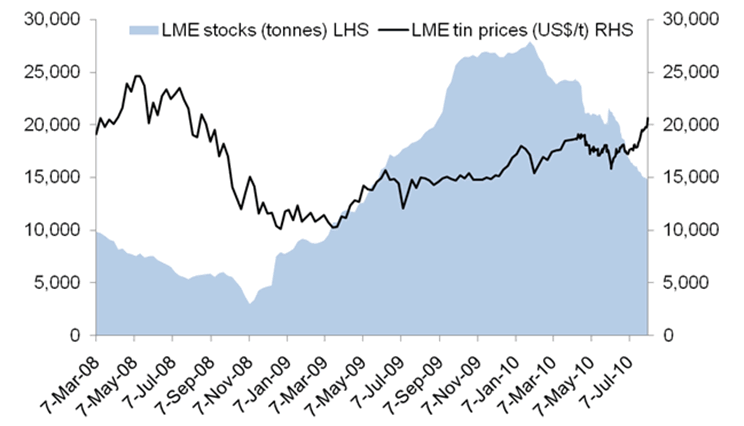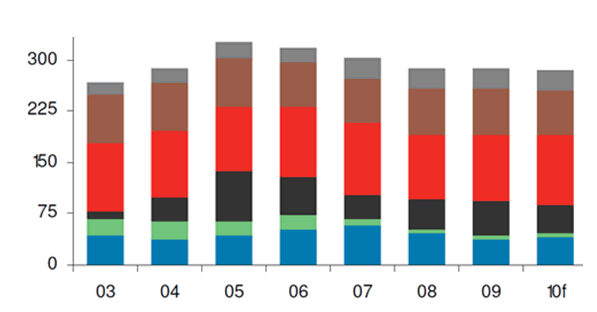Tin, an Overlooked Commodity
Commodities / Metals & Mining Aug 19, 2010 - 02:24 AM GMTBy: Alex_Cowie
 I want to introduce you to one of the most overlooked metals in the commodity complex. On a price basis, it’s been a star performer. Yet it hasn’t attracted much attention.
I want to introduce you to one of the most overlooked metals in the commodity complex. On a price basis, it’s been a star performer. Yet it hasn’t attracted much attention.
That’s just the way I like it, though. It gives you a chance to examine the dynamics of the market without rushing. In this case, the dynamics are very strong. The supply side is constrained; a situation that almost always puts upward pressure on prices. The demand side is strong too, as the recent price action shows.
If you’re able to find a low-cost producer of a metal with these kinds of dynamics—and you’re able to buy that company before it’s been fully ‘de-risked’—then you have a chance to make very large gains as the company moves closer to production.
Stockpiles falling, demand rising
The metal I’m talking about is tin. Worldwide demand is running well ahead of struggling production and the entire tin market is heading straight into a prolonged shortage where the highest bidder wins.
The result is that there is already a global tin shortage. This is getting worse by the minute and there is no relief in sight. There is no substitute for tin, and no one is developing any new mines big enough to bridge the growing shortfall.
The best illustration of this is the astonishing speed at which the spare tin inventory has disappeared in the last six months. This slack in the system is represented by the blue section of the chart below. This shows the size of the tin stockpiles held by the London Metals Exchange.
Since the start of the year, it has nearly halved. At this rate, it could all be gone by next Easter. And what then?
Tin stockpiles (in blue) falling fast

Source: Petra Capital
None of the other commodities are burning through their inventories at anything like the speed that tin is. The closest competitor is copper, which is being soaked up at not even half the speed. This shortage in supply, dwindling inventory and rising demand has led to a tin ‘deficit’ about 5% the size of the global market.
This deficit of tin in the market means one thing: Strong tin prices.
The tin price is currently at $21,700, and jumping every day.
In the first half of this year tin was the only base metal to rise in price at all, gaining 12.2% in six months. This was despite 30% of tin inventory being mopped up by buyers over this period. In the last three months of choppy markets it has out-performed all other commodities hands down with a gain of 27%.
With a 38% gain over the last twelve months, tin has been the best performer out of nearly every single hard or soft commodity you could think of. It was bettered only by palladium (78.7%), and Richard Bay Coal (39.3%) both of which I am happy to say Diggers and Drillers readers have exposure to already through recent recommendations. The only other commodity out-gunning tin is wheat, only because the recent Russian wheat export has made prices jump in recent weeks.
Tin’s market dynamics and good performance in ‘fair-weather and foul’ tells us one thing: we can be far more confident about the tin price being strong in the future, than we can be for other commodities.
So why haven’t we all heard about this sooner?
Mostly because the tin market is very small.
The entire global tin production amounts to just 0.29 million tonnes, worth just $6 billion, annually.
Compare this to global copper production which is closer to 16 million tonnes, worth $120 billion, annually.
It is often in overlooked commodities where the real opportunities lie.
You could call tin ‘the micro-cap of base metals’. And like all good micro-caps, it is capable of some impressive price jumps once the market is behind it, as it is now.
World needs more and more tin each year
The demand for tin is quite steady, and is growing at about 5% a year. So what is it used for?
Just over half of the world’s tin goes into solder and is used for joining wires to circuit boards. Your mobile contains about 8 grams of tin for example. Televisions, computers, microwave ovens; if it’s got a circuit-board in it, it contains tin. It has a low melting point which makes it ideal for this purpose. We are unknowingly surrounded by the stuff but know nothing about it.
A few years ago Chinese and European producers of electronic goods legally had to stop using solder with 40% lead and 60% tin, for health reasons, and start using solder with 97.5% tin. This single policy change increased global tin demand by over 20%.
There is speculation that the US could follow the same path, as California enacted law earlier this year preventing the sale of items that don’t pass the same European ‘Restriction of Hazardous Substances’ standards. If all US states went for 98% tin solder as well, this move would create a great deal more tin demand.
The rest of the tin is used for ‘tin-plating’ which is coating steel cans to make tin cans, for production of bronze, and various chemical processes. It is also used in lithium ion batteries. Projections for electric car use in China are massive, and this could crank up tin demand even further.
...but the supply of tin is crashing and no new big mines are being built
The world saw ‘peak-tin’ in 2005 and
since then production has fallen by 13% from 325,000 tonnes a year to less than 283,000 tonnes a year.
A near halving of production out of Indonesia has been a big part of this, as the chart below shows. Indonesia is covered by the blue/green/black bars. The higher grade Indonesian ore has now mostly been extracted, and the government has cracked down on small, environmentally damaging operations. Production from Brazil is starting to drop because of industry reorganisation, and Peru is struggling to keep up previous production rates. Meanwhile, supply from DR Congo is falling because of ethical issues [can you be more specific about this...just a bit vague].
Peak tin production was back in 2005 – It’s now less than 300,000 tonnes a year

Source: BNP Paribas
The world’s biggest tin producer is China (the red bar) with about a third of total production. However, China is also the world’s biggest user, and overall it is a net importer of tin.
This is an important point: it means China uses more than it produces so is buying from the other countries like the rest of us. This leaves the whole world fighting over the dwindling production from Indonesia, South America and DR Congo.
The net effect of this dwindling supply and rising demand is that tin prices should keep rising for the foreseeable future. It seems we are moving into a ‘structural deficit’ where there is no visible solution on the horizon.
BNP Paribas expect tin to be more than $23,000 / tonne as soon as next year. This seems quite feasible to me.
There is clearly a growing need for a sizeable tin producer to capitalise on this growing deficit in the market.
Alex Cowie is the head analyst of the resource investment advisory service Diggers and Drillers - Alex holds a graduate degree in finance and investment from the Financial Services Institute of Australia. Trained in Industrial Equity Analysis and Applied Portfolio Management, he is the editor and chief analyst for Diggers and Drillers and contributes regularly to the free e-letters The Daily Reckoning and Money Morning Australia.
Copyright © 2010 Alex Cowie - All Rights Reserved Disclaimer: The above is a matter of opinion provided for general information purposes only and is not intended as investment advice. Information and analysis above are derived from sources and utilising methods believed to be reliable, but we cannot accept responsibility for any losses you may incur as a result of this analysis. Individuals should consult with their personal financial advisors.© 2005-2022 http://www.MarketOracle.co.uk - The Market Oracle is a FREE Daily Financial Markets Analysis & Forecasting online publication.



